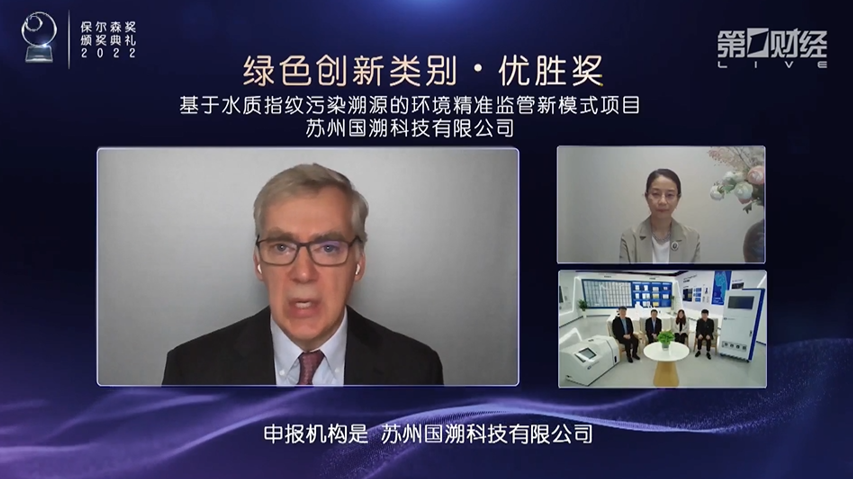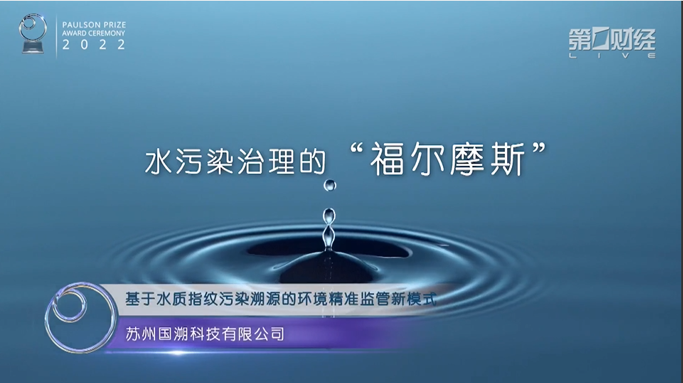School of Environment, Tsinghua University, December 17, 2022 (Correspondent Cheng Cheng) On December 15, the award ceremony of the 2022 Paulson Prize for Sustainability (hereinafter referred to as the “Paulson Prize”), jointly organized by the Paulson Institute and Tsinghua University, was held online. The project “Innovative Pollution Monitoring Technology and Supervision Model Based on Aqueous Fingerprint” won the Best Award in the category of “Green Innovation”. The project is transformed from research results of the Research Center of Environmental Technology on Water Pollution Source Identification and Precise Supervision (hereinafter referred to as “WPSI-PS Research Center”) of Tsinghua University’s School of Environment, and declared by Suzhou G-Seeker Technology Co., Ltd (hereinafter referred to as “GSeeker®”), which was a specialized industrialization company incubated by Research Institute for Environmental Innovation (Suzhou) Tsinghua. It was awarded for its “transformative impact through innovative technologies and models, as well as intelligent and strategic data application and analysis”.

“The Paulson Prize” is a highly influential annual award in the field of global sustainability, which recognizes and rewards innovative, replicable market solutions with both economic and environmental benefits implemented in China, providing replicable and innovative practices for the world to lead global sustainable transformation with a focus on China and an eye on the world. Professor Nie Jianguo, Director of the Academic Committee of Tsinghua University and Academician of the Chinese Academy of Engineering, said in his speech: “green development based on ecological civilization is the viable path for sustainable development of human society. China is actively exploring ways to promote green development, combat climate change and protect biodiversity, providing useful references for countries around the world, which is the reason that Tsinghua University and the Paulson Institute join hands in their commitment to promote sustainable development.”

Relying on the School of Environment, the WPSI-PS Research Center is focused on innovative water pollution sources monitoring technology and equipment based on Aqueous Fingerprint and industrialization research to meet the major needs of precise national water environment supervision. Its pioneering Aqueous Fingerprint technology has broken through the bottleneck of difficult and slow traceability in the field of water pollution prevention and control, invented the first international “Aqueous Fingerprint Equipment (G-seeker®)”, and built the world’s most comprehensive “aqueous fingerprint database”. It has covered more than 85% of the country’s total wastewater industries, and the first demonstration project and instrument production line were built. The Aqueous Fingerprint technology and products have been promoted and applied to 23 provinces and autonomous regions across China, forming a new model of precise environmental supervision of “real-time pollution discovery, precise investigation of pollution discharge sources, and efficient law enforcement” and improving supervision efficiency by more than 20 times. In recent years, it has also started to be applied in new directions, such as environmental law enforcement, hazardous waste identification and cross-border river pollution sources identification, effectively supporting the country’s strategic action to carry out in-depth protection of clean water and precise pollution control in many ways.

This project has received strong support from Tsinghua University, China National Environmental Monitoring Center, Suzhou Environmental Monitoring Center of Jiangsu Province, Shenzhen Ecological and Environmental Monitoring Center of Guangdong Province, International Cooperation and Exchange Center, Ministry of Ecology and Environment of the People’s Republic of China, Center for Ecological and Environmental Monitoring and Scientific Research, Yangtze River Basin Ecological and Environmental Supervision and Administration, Ministry of Ecology and Environment Research Institute for Environmental Innovation (Suzhou) Tsinghua.
The School of Environment, in particular, is not only the home of the core technology of the prize-winning project, but also provides excellent R&D conditions for the continuous upgrading of Aqueous Fingerprint technology and equipment, creating a solid basic research platform in the industry-university-research-application system. With the support of the School of Environment, members of WPSI-PS Research Center, as the main drafter, have completed the “Technical Guidelines for the Pollution Source Identification and Monitoring of Surface Water Pollution ” issued by the China National Environmental Monitoring Center, the association standard technical requirement for online water pollution early warning and discharge source identification equipment of aqueous fluorescence fingerprint was officially released on January 1, 2022. They are also preparing the industry standard “Technical Guidelines for Supervision and Management of Sewage Outfalls into Environmental Water Bodies—Source tracing of Aqueous Fingerprint Methods” to promote the normalization and standardization of Aqueous Fingerprint technology, instruments and applications.
The WPSI-PS Research Center will continue to take “guarding a better environment for human beings” as its mission, devote to providing better Aqueous Fingerprint technology, instruments and comprehensive solutions for the water environment supervision industry, so as to contribute more to the improvement of China’s water environment quality and safety assurance.





